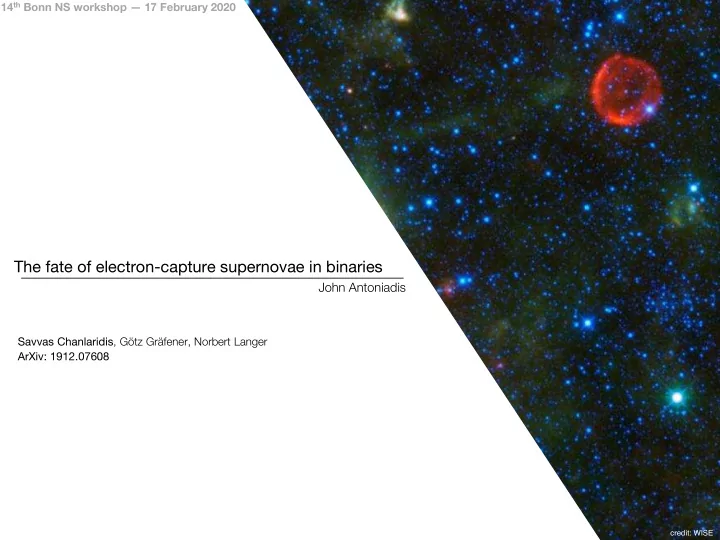

14 th Bonn NS workshop — 17 February 2020 The fate of electron-capture supernovae in binaries John Antoniadis Savvas Chanlaridis , Götz Gräfener, Norbert Langer ArXiv: 1912.07608 credit: WISE
14 th Bonn NS workshop — 17 February 2020 Type Ia supernovae from non-accreting progenitors John Antoniadis Savvas Chanlaridis , Götz Gräfener, Norbert Langer ArXiv: 1912.07608 credit: WISE
Electron-capture supernovae (ECSNe): a primer ZAMS masses below ~7 Msun make CO white dwarfs ZAMS masses above ~10 Msun make neutron stars / black holes What about stars in between? A difficult question… Dohertly et al. 2015
Electron-capture supernovae (ECSNe): a primer 7—10 Msun mass range is dominated by super-AGB stars: non-explosive carbon burning Thermal pulses Second dredge-up Poelarends et al. 2008 Poelarends et al. 2008 weak interactions off-centre C-burning Schwab et al. 2017 Farmer et al. 2015
Electron-capture supernovae (ECSNe): a primer Neon consumes a lot of electrons leading to collapse electron consumption vs runaway nuclear burning Outcome depends sensitively on initial conditions (density) and flame propagation core-collapse thermonuclear ECSN ECSN multi-D simulations for 𝜍 ! ≃ 10 "# gcm $ predict tECSNe that eject 0.1–1.0 Msun and leave behind small bound ONeFe white dwarfs (Jones et al. 2016/2019).
ECSNe in binaries In isolation, very few SAGB stars reach 𝑁 %& What about binaries? Some aspects more complicated, but if the H-envelope is removed then 2DU and thermal pulses are avoided! Core grows via stable shell burning More (all?) SAGB stars reach 𝑁 %& Dohertly et al. 2015
ECSNe in binaries 2.5 Msun helium star, solar metallicity JA, Chanlaridis, Gräfener & Langer, 2020, A&A; ArXiv:1912.07608
ECSNe in binaries 2.5 Msun helium star, solar metallicity helium burning carbon burning shells merge oxygen ignition JA, Chanlaridis, Gräfener & Langer, 2020, A&A; ArXiv:1912.07608
ECSNe in binaries 2.5 Msun helium star, solar metallicity JA, Chanlaridis, Gräfener & Langer, 2020, A&A; ArXiv:1912.07608
ECSNe in binaries What flavour of Type Ia? ✓ Short delay times in respect to star formation ✓ Owing to IMF, rates comparable to Ib/c ✓ Explosions possible for both stars in a binary JA, Chanlaridis, Gräfener & Langer, 2020, A&A; ArXiv:1912.07608
ECSNe in binaries What flavour of Type Ia? ✓ Short delay times in respect to star formation ✓ Owing to IMF, rates comparable to Ib/c ✓ Explosions possible for both stars in a binary ✓ The available nuclear energy suffices to unbind the star and to produce ejecta with kinetic energies of order 0.8-1.2 x 10 51 erg ✓ Depending on deflagration-to-detonation transition anything from Type Iax to SC Ia is possible JA, Chanlaridis, Gräfener & Langer, 2020, A&A; ArXiv:1912.07608
Summary ✓ Helium stars with masses between 1.8 and 2.7 solar masses evolve into near-M ch ONeMg or hybrid CO/ONeMg objects ✓ These cores ignite explosively at "low" densities, and therefore they most likely disrupt ✓ Available nuclear energy suffices to yield ejecta velocities similar to what is expected for a typical Ia ✓ Frequency comparable to type Ib/c rates ✓ Short delay times in respect to star formation: relevant to SNe iin star-forming galaxies
Recommend
More recommend